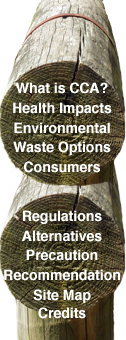Regulations
European Union
![]() Restrictions
on Use of CCA-Treated Timber
Restrictions
on Use of CCA-Treated Timber
![]() Risk
Assessment
Risk
Assessment
![]() Industry
Response
Industry
Response
![]() References
References
Restrictions on Use of CCA-Treated Timber
Since June 2004, the use of CCA-treated timber has been severely curtailed with an amendment of the European Union Commission Directive 76/769/EEC. This amendment now states that arsenic compounds may not be used ‘in the preservation of wood. Furthermore, wood so treated may not be placed on the market’. The only exceptions are wood to be used in industrial installation that ‘the structural integrity of the wood is required for human or livestock safety and skin contact by the general public during is service life is unlikely’. The following uses are specifically not allowed (Commission Directive 2003/2/EC, 6 January 2003):
- in residential or domestic constructions, whatever the purpose,
- in any application where there is a risk of repeated skin contact
- in marine waters,
- for agricultural purposes other than for livestock fence posts and structural uses…
- in any application where treated wood may come into contact with intermediate or finished products intended for human and/or animal consumption.
The EU amendment therefore restricts the marketing and use of both the CCA chemical as well as timber treated with CCA, and will also apply to imported treated wood and waste wood in re-use. In addition, it is anticipated that from 2007, CCA preservatives will require authorisation according to The Biocidal Products Directive (BPD)19 (Enviros Consulting et al, 2004). The EU regulations, however, do not apply to CCA-treated wood already in service. CCA-treated timber has not been as extensively used in Europe as it has in Australia however.
The EU amendment is the consequence of a risk assessment by the European Commission Enterprise Directorate General that identified a number of unacceptable risks, including risks to children from CCA-treated timber play equipment, environmental risks from combustion and disposal (including leaching in landfill) and to aquatic organisms, and health risks from use of CCA-treated timber (cited in DEFRA, 2003).
The European Communities’ Scientific Committee for Toxicity, Ecotoxicity and the Environment (CSTEE) evaluated this risk assessment, and determined that no threshold exists for the carcinogenic effects of arsenic (which is also known to be genotoxic). The CSTEE could not establish the arsenic-related risks of landfill disposal of CCA-treated timber, which is classified as a hazardous waste by the Commission in 2000, and thus concluded that it was appropriate to apply the precautionary principle and, in the absence of proof of harm, reduce the production of CCA-treated timber as much as possible because it is likely to cause serious harm (CSTEE, 2003).
The treated timber industry has responded to these Directives by considering alternative treatments in order to maintain their market share over other materials. A representative from Arch Timber Protection UK, has boasted that since moving away from arsenic- and chromium-based timber preservatives in the mid-1990s, ‘companies embraced the challenge and through the change to copper based preservatives, aggressively marketed own brands and unique features of their products. Contrary to many forecasts, the industry has flourished and benefited from the changes as treated wood continues to be the material of choice’ (Connell, 2004).
In 2003, after a consultation process by the Department of Environment, Food and Rural Affairs, Great Britain adapted the above EC regulations (DEFRA, 2003). This resulted in closer attention being put on the timber treatment industry, with legal action being taken against a CCA timber treatment company for improper and unsafe use of pesticides and a fine of £30,000. Anglian Timber was found guilty of machining timber within 48 hours of treatment, transporting wet (unfixed) timber, and not providing personal protective equipment for employees (EHN Online, 2004).
In addition, in Northern Europe the use of chromium-based preservatives is also being restricted and they are banned in Denmark (Connell, 2004).
Connell, M. (2004), ‘Issues Facing Preservative Suppliers in a Changing Market For Treated Wood’, Paper presented to COST Action E22: Environmental Optimisation of Wood Protection, Lisboa œ Portugal, 22- 23 March.
CSTEE (Scientific Committee on Toxicity, Ecotoxicity and the Environment) (2003), ‘Commission Directive 2003/2/EC of 6 January 2003 relating to restrictions on the marketing and use of arsenic (tenth adaptation to technical progress to Council Directive 76/769/EEC)’, Official Journal of the European Communities, January 9, L 4/9.
DEFRA (2003), Consultation on the transposition of the 10th adaptation to technical progress of Annex I to Council Directive 76/769/EEC relating to restrictions on the marketing and use of arsenic in England, Scotland and Wales (Great Britain), August, Department for Environment, Food and Rural Affairs, Great Britain.
EHN Online (2004), ‘Timber firm exposed employees to pesticides’, Environmental Health News Online, http://www.ehn-online.com/cgi-bin/news/legals/epavafeyzuucodpohu.html; September 23.
Enviros Consulting and The BioComposites Centre, University of Wales (2004), Treated Wood Waste: Assessment of the Waste Management Challenge, The Waste & Resources Action Programme (WRAP), UK.


